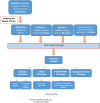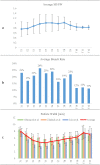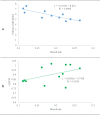Currently Adopted Criteria for Pedicle Screw Diameter Selection
- PMID: 31131212
- PMCID: PMC6510178
- DOI: 10.14444/6018
Currently Adopted Criteria for Pedicle Screw Diameter Selection
Abstract
Background: Transpedicular screw insertion has become widely accepted for the correction of spinal deformity as well as degenerative and traumatic injury, but adoption of this technique has remained less widespread in the thoracic compared to the lumbar spine. This is thought to be associated with the relative technical difficulty of screw insertion into the narrower widths of the thoracic pedicles and the neurologic and mechanical risks associated with breach of the pedicle wall. The surgical decision making involves determining the appropriate sized screw for maximum fixation strength while simultaneously respecting the structural integrity of the vertebral pedicles to prevent a breach and provide better fixation. This paper presents a systematic review of criteria for thoracic pedicle screw diameter (SD) selection in order to orient inexperienced surgeons on the impact of this selection on pedicle breaching and fixation strength.
Methods: We performed a systematic literature review focused on studies reporting SD selection in relation to pedicle dimensions, measures of fixation strength, and breach rate.
Results: Twenty-nine articles that measured fixation strength, breach rate, and/or provided SD in relation to pedicle width were selected for inclusion.
Conclusions: A commonly accepted criteria for pedicle SD selection has not yet been proposed. Screw diameters approximately 80% of the pedicle width have been adopted, but this proportion is rarely reported in the midthoracic vertebrae for which smaller pedicles and inadequate hardware specificity result in higher breach rates. Depending upon the insertion technique adopted, greater specificity in diameter selection by vertebral level should be pursued in order to maximally target cortical bone purchase.
Clinical relevance: Based on this review of the literature, we believe that proper selection of the SD for individual vertebral level directly affects the insertion technique and the potential breach.
Keywords: bone fixation; fusion; pedicle screws; spine instrumentation; thoracic spine.
Figures




Similar articles
-
Placement of pedicle screws in the human cadaveric cervical spine: comparative accuracy of three techniques.Spine (Phila Pa 1976). 2000 Jul 1;25(13):1655-67. doi: 10.1097/00007632-200007010-00009. Spine (Phila Pa 1976). 2000. PMID: 10870141
-
The effect of pedicle screw redirection after lateral wall breach--a biomechanical study using human lumbar vertebrae.Spine J. 2014 Jan;14(1):98-103. doi: 10.1016/j.spinee.2013.03.028. Epub 2013 Apr 23. Spine J. 2014. PMID: 23623630
-
Incidence of lumbar spine pedicle breach after percutaneous screw fixation: a radiographic evaluation of 601 screws in 151 patients.J Spinal Disord Tech. 2014 Oct;27(7):358-63. doi: 10.1097/BSD.0b013e31826226cb. J Spinal Disord Tech. 2014. PMID: 22688617 Clinical Trial.
-
Current trends in pedicle screw stimulation techniques: lumbosacral, thoracic, and cervical levels.Neurodiagn J. 2012 Jun;52(2):100-75. Neurodiagn J. 2012. PMID: 22808751 Review.
-
Posterior thoracic segmental pedicle screw instrumentation: evolving methods of safe and effective placement.Neurol India. 2005 Dec;53(4):458-65. doi: 10.4103/0028-3886.22613. Neurol India. 2005. PMID: 16565538 Review.
Cited by
-
Two-screw osteosynthesis is biomechanically superior to single-screw osteosynthesis for type II odontoid fractures.Sci Rep. 2024 Aug 15;14(1):18947. doi: 10.1038/s41598-024-69905-3. Sci Rep. 2024. PMID: 39147821 Free PMC article.
-
Biomechanical Effect of Different Posterior Fixation Techniques on Stability and Adjacent Segment Degeneration in Treating Thoracolumbar Burst Fracture With Osteoporosis: A Finite Element Analysis.Spine (Phila Pa 1976). 2024 Aug 1;49(15):E229-E238. doi: 10.1097/BRS.0000000000005034. Epub 2024 May 9. Spine (Phila Pa 1976). 2024. PMID: 38721831 Free PMC article.
-
Incomplete insertion of pedicle screws triggers a higher biomechanical risk of screw loosening: mechanical tests and corresponding numerical simulations.Front Bioeng Biotechnol. 2024 Jan 8;11:1282512. doi: 10.3389/fbioe.2023.1282512. eCollection 2023. Front Bioeng Biotechnol. 2024. PMID: 38260754 Free PMC article.
-
Biomechanical evaluation of different posterior fixation techniques for treating thoracolumbar burst fractures of osteoporosis old patients: a finite element analysis.Front Bioeng Biotechnol. 2023 Nov 1;11:1268557. doi: 10.3389/fbioe.2023.1268557. eCollection 2023. Front Bioeng Biotechnol. 2023. PMID: 38026889 Free PMC article.
-
How to Optimize Pedicle Screw Parameters for the Thoracic Spine? A Biomechanical and Finite Element Method Study.Global Spine J. 2024 Jan;14(1):187-194. doi: 10.1177/21925682221099470. Epub 2022 May 2. Global Spine J. 2024. PMID: 35499547 Free PMC article.
References
-
- Cuartas E, Rasouli A, O'Brien M, Shufflebarger HL. Use of all-pedicle-screw constructs in the treatment of adolescent idiopathic scoliosis. J Am Acad Orthop Surg. 2009;17(9):550–561. - PubMed
-
- Lykissas MG, Jain VV, Nathan ST, et al. Mid- to long-term outcomes in adolescent idiopathic scoliosis after instrumented posterior spinal fusion: a meta-analysis. Spine (Phila Pa 1976) 2013;38(2):E113–E119. https://doi.org/10.1097/BRS.0b013e31827ae3d0. - DOI - PubMed
-
- Crawford AH, Lykissas MG, Gao X, Eismann E, Anadio J. All-pedicle screw versus hybrid instrumentation in adolescent idiopathic scoliosis surgery: a comparative radiographical study with a minimum 2-year follow-up. Spine (Phila Pa 1976) 2013;38(14):1199–1208. https://doi.org/10.1097/BRS.0b013e31828ce597. - DOI - PubMed
-
- Hartl R, Theodore N, Dickman CA, Sonntag VKH. Technique of thoracic pedicle screw fixation for trauma. Oper Tech Neurosurg. 2004;7(1):22–30. https://doi.org/10.1053/j.otns.2004.04.005. - DOI
-
- Payer M. Unstable upper and middle thoracic fractures. Preliminary experience with a posterior transpedicular correction-fixation technique. J Clin Neurosci. 2005;12(5):529–533. https://doi.org/10.1016/j.jocn.2004.11.006. - DOI - PubMed
LinkOut - more resources
Full Text Sources
